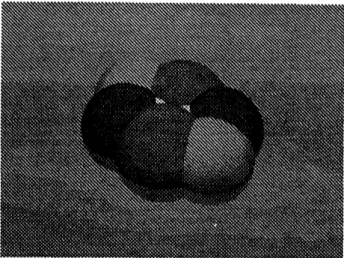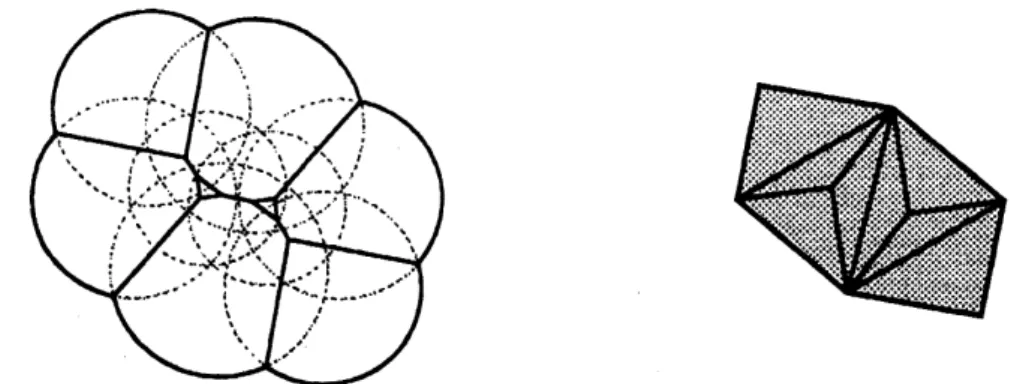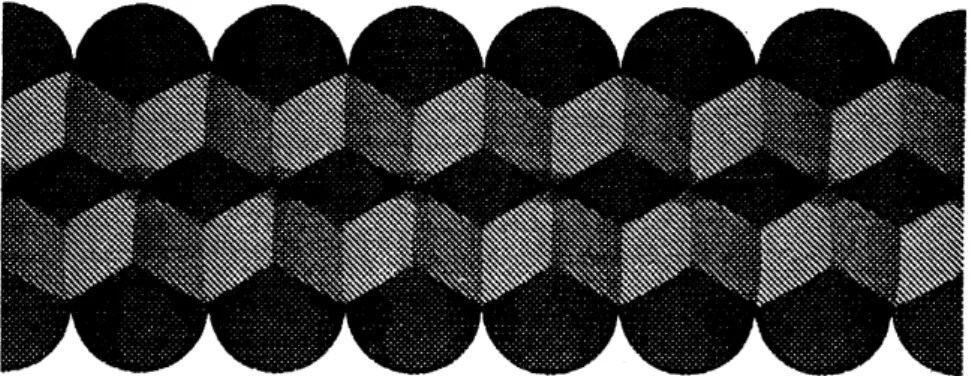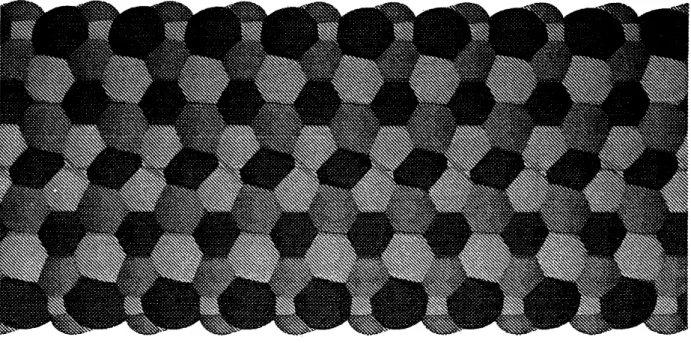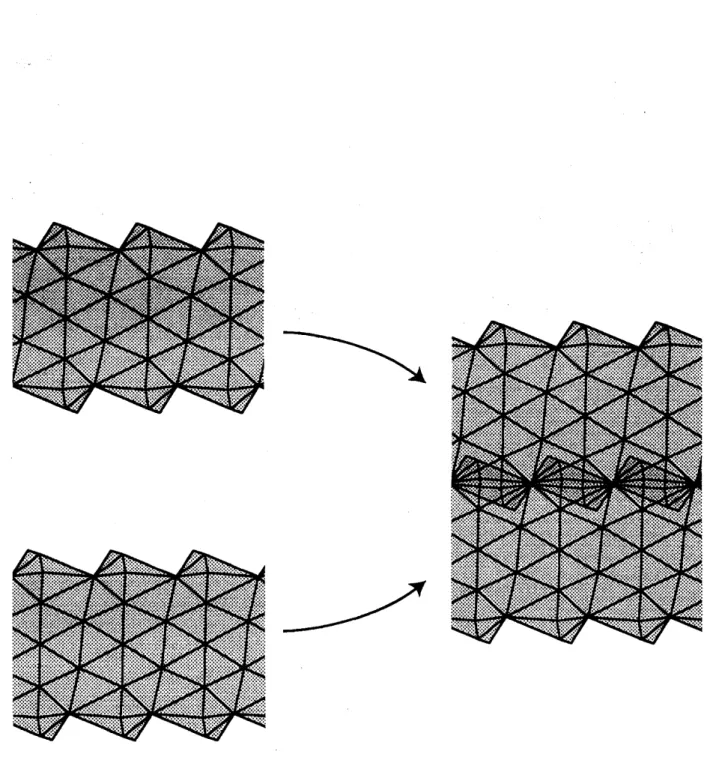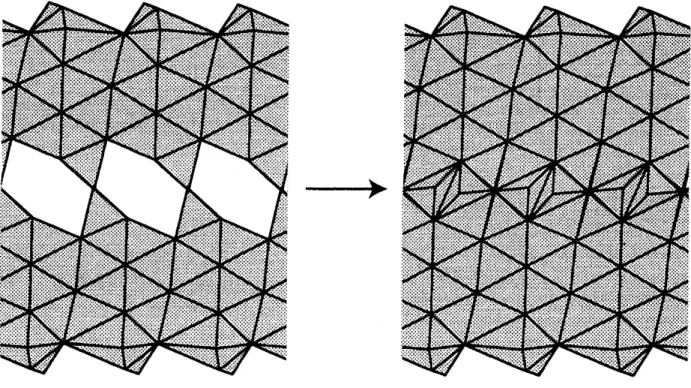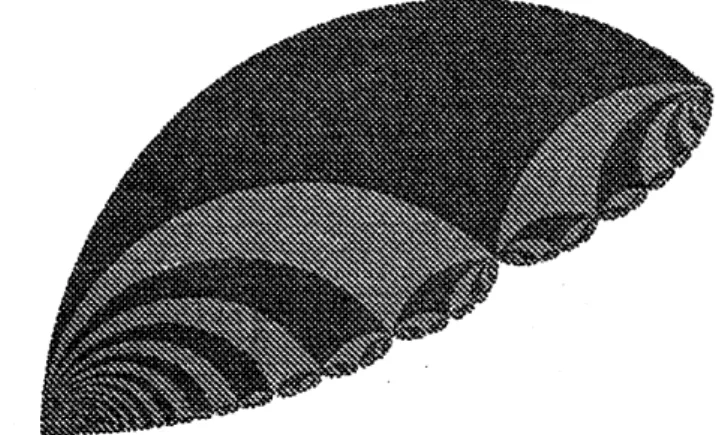Ford
domains
of
a
certain
hyperbolic
3-manifold whose boundary consists
of
a
pair
of once-punctured tori,
II
大阪市立大学数学研究所
秋吉宏尚 (HirotakaAkiyoshi)
Osaka
City
University
Advanced
Mathematical Institute
1
Introduction
This is
a
sequel to [3]. Our initial problem is the following.Problem 1.1. Characterize the combinatorial structures of the Ford
do-mains forhyperbolic structures on a 3-manifold which has apair of punctured
tori as boundary.
The Jorgensen theory tells in detail the combinatorial structures of the
Ford domains of hyperbolic structures on punctured torus bundles. We
ex-pect to understand in detail the hyperbolic structures on manifolds with
non-fiber surfaces from the combinatorial structures of Ford domains.
Prob-lem 1.1 is the first step to the attempt to fill in the box with “???” in the
following table, which tells the relation between analytic and combinatorial
aspects of Thurston’s Hyperbolization Theorem for Haken manifolds.
2
A
family
of
3-manifolds with
a
pair
of
punc-tured
tori
as
boundary
We denote the one-holed torus (resp. once-punctured torus) by $T_{0}$ (resp. $T$).
Let $\gamma$ be an essential simple closed curve on the level surface $T_{0}\cross\{0\}$ of
For
a
pair of coprime integers , let be the result of Dehnfilling
on
$M_{0}$ with slope $p\mu+q\lambda$, i.e., the manifold obtained from $M_{0}$ bygluing the solid torus $V$ by
an
orientation-reversing homeomorphism $\partial Varrow$$\partial N(\gamma)\subset\partial M_{0}$
so
that the meridian of $V$ is identified with a simple closedcurve on
$\partial N(\gamma)$ of slope$p\mu+q\lambda$. We regard $M_{0}$ as a submanifold of $M(p, q)$by using the canonical embedding. In particular, $M(\pm 1,0)$ is canonically
homeomorphic to the product $T_{0}\cross[-1,1]$
.
Proposition 2.1. For any pair
of
coprime integers $(p, q),$ $M(p, q)$ ishome-omorphic to the handlebody
of
genus 2.Set $P=\partial T_{0}\cross[-1,1]$
.
In contrast to Proposition 2.1, the pair $(M(p, q),P)$does not necessarily admit a product structure.
Proposition 2.2. The
surfaces
$T_{0}^{\pm}$ is incompressible in $M(p, q)$if
and onlyif
$(p, q)\neq(0, \pm 1)$.
In this case, itfollows
that $(M(p, q),$$P$) is an atoroidalHaken pared
manifold
in the sense of [12].By the Thurston’s Hyperbolization Theorem for Haken pared manifolds
(cf. [12, Theorem 1.43]), we obtain the following corollary.
Corollary
2.3.
For any pairof
coprime integers $(p)q)\neq(0, \pm 1),$ $M(p, q)$admits a complete geometrically
finite
hyperbolic structure with the parabolic locus $P$.
For the rest ofthis paper, $(p, q)$ denotes apair ofcoprime integers distinct
from $(0, \pm 1)$
.
Definition 2.4. We shall denote by $\mathcal{M}\mathcal{P}(p, q)$ the space of geometrically
finite (marked) hyperbolic structures onthe pared manifold $(M(p, q),$$P$) with
the parabolic locus $P$
.
By Corollary 2.3, $\mathcal{M}\mathcal{P}(p, q)$ is not empty. The following proposition
fol-lows from Marden’s isomorphism theorem.
Proposition 2.5. The space $\mathcal{M}\mathcal{P}(p, q)$ is isomorphic to the square $\mathcal{T}\cross \mathcal{T}$
3
Punctured
torus
groups
We fix a generator pair $(\alpha, \beta)$ of $\pi_{1}(T)$ and denote the commutator $[\alpha, \beta]=$ $\alpha\beta\alpha^{-1}\beta^{-1}$ by $\kappa$
.
Definition
3.1. A representation $\rho$ : $\pi_{1}(T)arrow PSL(2, \mathbb{C})$ is a (marked)punctured torus group if it is a faithful discrete representation which maps $\kappa$
to a parabolic element. Two punctured torus
groups
are said to be equivalent if they are conjugate to each other. Denote the set of equivalence classes ofpunctured torus groups $by\overline{Q\mathcal{F}}$
.
The set $\overline{\mathcal{Q}\mathcal{F}}$is identified with a subset of the$PSL(2, \mathbb{C})$-representation space of $\pi_{1}(T)$. The topology on $\overline{\mathcal{Q}\mathcal{F}}$
is induced
from this identification.
For any $\rho\in\overline{Q\mathcal{F}},$ $\mathbb{H}^{3}/p(\pi_{1}(T))$ is homeomorphic to Int$(T_{0}\cross(-1,1))$
.
Foreach end of $T_{0}\cross(-1,1)$,
one can
define the end invariant of $\rho$, denoted by$\lambda^{\epsilon}(\rho)(\epsilon\in \{-, +\})$, as follows. If there is asimply connected component of
the domain of discontinuity of $\rho(\pi_{1}(T))$ corresponding to the end, then its
quotient determines amarked conformal structure on $T$, which is defined to
be the end invariant $\lambda^{\epsilon}(\rho)\in \mathcal{T}$
.
If the subset of domain of discontinuity of$\rho(\pi_{1}(T))$ corresponding to the end is the disjoint union of countable family
of round disks, then its quotient determines amarked conformal structure
on $T$ with node, which is defined to be the end invariant $\lambda^{\epsilon}(\rho)\in\partial_{\mathbb{Q}}\mathcal{T}$
.
If the subset of domain of discontinuity of $\rho(\pi_{1}(T))$ corresponding to the
end is empty, then
one can
define the end invariant $\lambda^{\epsilon}(\rho)\in\partial \mathcal{T}-\partial_{\mathbb{Q}}\mathcal{T}$ byusing
asequence
of simple closed geodesics whlch exits the end. Here $\mathcal{T}$ iscompactified via Thurston’s compacticfication. Then $\mathcal{T}$ (resp. $\mathcal{T}\cup\partial \mathcal{T}$ and
$\partial_{\mathbb{Q}}\mathcal{T})$ is canonically identified with $\mathbb{H}^{2}$ (resp. $\overline{\mathbb{H}^{2}}$
and $\partial_{\mathbb{Q}}\mathbb{H}^{2}=\hat{\mathbb{Q}}=\mathbb{Q}\cup\{\infty\}$).
(See [14] for details.)
Definition 3.2. The end invariant map $\lambda$ : $\overline{\mathcal{Q}\mathcal{F}}arrow \mathbb{H}^{2}\cross \mathbb{H}^{2}-diag(\partial \mathbb{H}^{2})$ is
defined by $\lambda(\rho)=(\lambda^{-}(\rho), \lambda^{+}(\rho))(\rho\in\overline{\mathcal{Q}\mathcal{F}})$ .
Theorem 3.3 (Minsky [14]). The end invariant map $\lambda=(\lambda^{-}, \lambda^{+})$ : $\overline{\mathcal{Q}\mathcal{F}}arrow$ $\overline{\mathbb{H}^{2}}\cross\overline{\mathbb{H}^{2}}-diag(\partial \mathbb{H}^{2})$ is a bijection and its inverse is a continuous map. $In$
particular, $\overline{Q\mathcal{F}}$ is equal to the closure
of
the quasifuchsian space $\mathcal{Q}\mathcal{F}$.
Given an element $\sigma\in \mathcal{M}\mathcal{P}(p, q)$, let $p_{\sigma}\wedge$ : $\pi_{1}(M(p, q))arrow PSL(2, \mathbb{C})$ be
the holonomy representation. Then let $\iota_{\sigma}$ : $\pi_{1}(T)arrow PSL(2, \mathbb{C})\cross PSL(2, \mathbb{C})$
be the composition $\iota_{\sigma}=(\rho_{\sigma}\wedge 0\iota_{*}^{-\wedge}\rho_{\sigma}0\iota_{*}^{+})$. The following proposition follows
from Proposition 2.2 and the covering theorem [7].
Proposition 3.4. The correspondence $\sigma\mapsto\iota_{\sigma}$ induces an embedding
of
Figure 1: Ford domain of a cyclic Kleinian group
4
Ford domain
In what follows, we
use
the upper half space model for $\mathbb{H}^{3}$.Definition 4.1. For an element $\gamma$ of $PSL(2,\mathbb{C})$ which does not stabilize $\infty$,
the isometric hemisphere, $Ih(\gamma)$, of $\gamma$ is the set of points in
$\mathbb{H}^{3}$ where
$\gamma$ acts
as an isometry with respect to the canonical Euclidean metric
on
the upperhalf space. We denote the exterior of $Ih(\gamma)$ by $Eh(\gamma)$.
Definition 4.2. For a Kleinian group $\Gamma$, the Ford domain,
$Ph(\Gamma)$, of $\Gamma$ is
defined by $Ph( \Gamma)=\bigcap_{\gamma\in\Gamma-\Gamma_{\infty}}Eh(\gamma))$ where $\Gamma_{\infty}$ is the stabilizer of $\infty$ in F.
For any hyperbolic structure $\sigma$
on
$M_{0}$or
$M(p, q)$, the Ford domain for $\sigma$ isdefined to be the Ford domain of the image of
a
holonomy representation for$\sigma$ which sends the peripheral element $[\partial T_{0}\cross\{0\}]$ of the fundamental
group
to $\{\begin{array}{ll}1 20 l\end{array}\}$ .
Example 4.3. The Ford domain $Ph(\langle\gamma\rangle)$ of the cyclic Kleinian group $\langle\gamma\rangle$,
generated by a loxodromic element $\gamma\in PSL(2, \mathbb{C})$ which does not stabilize
$\infty$, is as depicted inFigures 1 and2. Every (face’ of$Ph(\Gamma)$ is supportedby an
isometric hemisphere; there
are 8
faces in this example. The characterizationof combinatorial structures of the Ford domains of cyclic Kleinian groups is
given by Jorgensen [10] (cf. [8]).
Let $\mathcal{D}=\{\gamma\langle\infty,0,1\rangle|\gamma\in PSL(2, \mathbb{Z})\}$ be the Farey tessellation of $\mathbb{H}^{2}$
.
The combinatorial structure of the Ford domain of $\rho(\pi_{1}(T))$ for $\rho\in\overline{\mathcal{Q}\mathcal{F}}$ is
characterized by the extension of Jorgensen’s side parameter $\nu=(\nu^{-}, \nu^{+})$ :
Figure 2: Ford domain of
a
cyclic Kleinian group and its dualFigure 3: Ford domain of a quasifuchsian punctured torus group
Here we briefly review the idea of the characterization. The combinatorial
structures of Ford domains are characterized by using EPH-decomposition
introduced in [4].
Definition 4.4. For a hyperbolic structure $\sigma$
on
$M_{0}$ or $M(p,q)$, let $\Delta_{E}(\sigma)$ bethe subcomplex of the EPH-decomposition for $\sigma$ consisting of the Euclidean
facets. Let $\Delta_{E,0}(\sigma)$ be the subcomplex of$\triangle_{E}(\sigma)$ consisting of the facetswhose
vertices correspond to the parabolic locus $P$
.
By the observation in [4, Section 10], it
can
be proved that $\triangle_{E,0}(\sigma)$ isdual to the Ford domain for $\sigma$
.
For any point $\nu\in\overline{\mathbb{H}^{2}}\cross\overline{\mathbb{H}^{2}}-diag(\partial \mathbb{H}^{2})$, a topological ideal polyhedral
complex Trg(v) is defined in [5, Section 5]. Then, for any $\rho\in\overline{\mathcal{Q}\mathcal{F}},$ $\Delta_{E,0}(\rho)$
is isotopic to $Rg(\nu(\rho))$ in the
convex core
of $\mathbb{H}^{3}/\rho(\pi_{1}(T))$ (see [5, Theorem5.1]). Figure 3 illustrates the Ford domain of a generic quasifuchsian
punc-tured torus group, and Figure 4 illustrates the intersection of $\Delta_{E}(p)$ and a
sufficiently small horosphere centered at $\infty$, which is the fixed point of the
Figure 4: Dual of Ford domain
5
Ford
domains
for hyperbolic
structures
in
$\mathcal{M}\mathcal{P}(p, q)$
To
answer
Problem 1.1 for the pared manifold $(M(p, q),$ $P$) with a coprimeintegers $(p, q)\neq(O, \pm 1)$, we will follow the following program.
(1) Construct a geometrically finite hyperbolic structure, $\sigma_{0}$,
on
the paredmanifold $(M_{0}, P\cup\partial N(\gamma)\cup N(\alpha^{\pm}))$ with the parabolic locus
$P\cup\partial N(\gamma)\cup$
$N(\alpha^{\pm})$, where $N(\alpha^{\pm})$ is the regular neighborhood in $T_{0}^{\pm}$ of the union of
two
simpleclosed
curves
$\alpha^{\pm}\subset T_{0}^{\pm}$.
(2) Construct a geometrically finite hyperbolic structure, $\sigma(p, q)$,
on
thepared manifold $(M(p, q),$$P\cup N(\alpha^{\pm}))$ in $\partial \mathcal{M}\mathcal{P}(p, q)$ by hyperbolic Dehn
filling on the structure $\sigma_{0}$
.
(3) By using the (geometric continuity” argument, which is used in the
Jor-gensen theory, characterize the combinatorial structures of Ford domains
of the structures in $\mathcal{M}\mathcal{P}(p, q)$
.
See Figures 5 and 6, which illustrates the Ford domains for $\sigma_{0}$ and $\sigma(3,5)$
.
For the step (1), the desired hyperbolic structure, $\sigma_{0}$, is obtained from
two copies of the manifold of the double cusp
group
$\lambda^{-1}$(oo, 1/2) by gluingalong a pair of boundary components of their convex
cores.
Definition 5.1. For each $s\in\hat{\mathbb{Q}}$ with $0<s<1$, let
$\Delta_{0}^{s}$ be the complex
ob-tained from the two copies of the complex $Rg(\infty, s)$ by gluing them together along the edge with slope $\infty$ (see Figure 7).
Figure 5: Ford domain for $\sigma_{0}$
Figure 6: Ford domain for $\sigma(3,5)$
Figure
8:
The link of the ideal vertex of $\triangle^{1/2}(p, q)$; this figure illustrates thecase
$(p, q)=(3,5)$Proposition 5.2. The complex$\Delta_{E,0}(\sigma_{0})$ is combinatorially equivalent to the
complex $\Delta_{0}^{1/2}$
.
For the step (2), the following Proposition 5.4 is proved by studying the
Ford domains after hyperbolic Dehn filling. See [2] for an outline, in which
the definition of layered sohd torus is not correct; it should be modified as
follows. The following construction is parallel to the construction of the
topological ideal triangulation of the two bridge link complement introduced
in [15]. Let $\sigma^{+}$ be the triangle of $\mathcal{D}$ with vertices $0,1/2$ and 1/3. For any
coprime integers $(p, q)$, let $l$ be the geodesic in $\mathbb{H}^{2}$ with endpoints $p/q$ and
$s^{+}\in\{0,1/2,1/3\}$ which intersects the interior of $\sigma^{+}$
.
Let$\sigma^{-}$ be the triangle
of$\mathcal{D}$ withvertex$p/q$ whose interior intersects$l$
.
Let $\sigma^{-,*}$ be the triangle whichshares an edge with $\sigma^{-}$ and does not contain $p/q$
.
Let $s^{-}$ be the vertex of$\sigma^{-,*}$ which is not contained in $\sigma^{-}$
.
We introduce the equlvalence $relation\sim_{s^{-}}$on the boundary component of $Rg(s^{-}, s^{+})$ corresponding to $\sigma^{-,*}$ following
[15,
Section
II.2]. Let $V(p, q)$ be the quotient space $Trg(s^{-}, s^{+})/\sim_{s^{-}}$.
Then$V(p, q)$ is homeomorphic to the solid torus with apoint
on
the boundaryremoved whenever $\sigma^{+}$ and $\sigma^{-,*}$ do not share an edge. We can see also that
the meridian of $V(p, q)$ has slope $p/q$
.
Definition 5.3. Let $\overline{V}\cdot(p, q)$ be the double cover of $V(p,q)$
.
For each $s\in \mathbb{Q}$with
$0<s<1$
, let $\Delta^{s}(p, q)$ be the complex obtained by gluing $\uparrow(p,q)\sim_{V}$ to $\triangle_{0}^{s}$ so that the triangle of $\partial\tilde{V}(p, q)$ with edges of slopes $(0,1/3,1/2)$ and thetriangle of $\partial\triangle_{0}^{s}$ with edges of slopes $(\infty, 0,1)$ are identified. (See Figure 8.
See also Figures
10
and 11.)Proposition 5.4. For all but
finite
coprime integers $(p, q)$, the complexFigure 9: Ford domain for a hyperbolic structure in $J_{sym}^{thick}\subseteq \mathcal{M}\mathcal{P}_{S\}},m(p, q)$
for $(p, q)=(3,5)$
Let $\mathcal{M}\mathcal{P}_{sym}(p\rangle q)$ be the subspace of $\mathcal{M}\mathcal{P}(p, q)$ consisting of the elements
whose image $(\lambda^{-},\cdot\lambda^{+})$ in $\mathcal{T}\cross \mathcal{T}$ by the map defined in Proposition 2.5 satisfies
that $\lambda^{+}$ is the mirror image of$\lambda^{-}$. Then $\sigma(p, q)$ is contained in $\partial \mathcal{M}\mathcal{P}_{sym}(p, q)$.
The symmetry of this kind seems to be useful to carry out the “geometric
continuity’) argument.
Question 5.5. Is the combinatorial structure of the Ford domain for every hyperbolic structure in $\mathcal{M}\mathcal{P}_{s\}},m(p)q)$ characterized by a way similar to that
given Fn Proposition 5.4?
We say a hyperbolic structure $\sigma\in \mathcal{M}\mathcal{P}_{sym}(p)q)$ is thick good if $\triangle_{E}(\sigma)$ is
combinatorially equivalent to $\triangle^{s}(p, q)$ for some $s\in \mathbb{Q}$ with
$0<s<1$
, anddenote the subset of $\mathcal{M}\mathcal{P}_{sym}(p, q)$ consisting of the thick good structures by
$\mathcal{J}_{sym}^{thick}$
.
Figure 9 illustrates the Ford domain for a hyperbolic structurecon-tained in $\mathcal{J}_{sym}^{thick}\subset \mathcal{M}\mathcal{P}_{sym}(p, q)$ for $(p, q)=(3,5)$. We can draw a conjectural
picture of $\mathcal{J}_{sym}^{thick}$ for $(p, q)=(3,5)$ as Figure 12. In the Pgure, the
hyper-bolic structures
are
parametrized by $Tr\rho(\gamma)$, where $\rho$ is a lift to a $SL(2, \mathbb{C})-$representation of the holonomy representation for the structure. A point in
the plane is colored
gray
if the corresponding representation determinesan
embedding into $\mathbb{C}$ ofa simplicial complex which is supposed to be the dual of
the Ford domain and if the radii of the isometric hemispheres corresponding to the vertices of the complex do not exceed 1. The condition
on
the radii of isometric hemispheres is necessary for the corresponding holonomyFigure 10: Idea of construction of the dual complex (1): The dual complex is
based on two copies of the dual complex for a quasifuchsian punctured torus
Figure 11: Idea of construction of the dual complex (2): By drilling and filling
with the dual complex for a cyclic Kleinian group, we obtain the desired
complex
according to the change of combinatorial structures of the Ford domains.
Question 5.6. How is the Forddomain for
a
hyperbolic structure in$\mathcal{M}\mathcal{P}(p,q)-$$\mathcal{J}_{sym}^{thick}$ characterized?
References
[1] H. Akiyoshi, “On the Ford domains of once-punctured torus groups”, Hyperbolic spaces and related topics, RIMS, Kyoto, Kokyuroku 1104
(1999), 109-121.
[2] H. Akiyoshi, (Canonical decompositions of cusped hyperbolic
3-manifolds obtained by Dehn fillings”, Perspectives
of
Hyperbolic Spaces,RIMS, Kyoto, Kokyuroku 1329, 121-132, (2003).
[3] H. Akiyoshi, “Ford domains of a certain hyperbolic 3-manifold whose
boundary consists of a pair of once-punctured tori”, Complex Analysis
and Geometry
of
Hyperbolic Spaces, RIMS, Kyoto, Kokyuroku 1518,Figure 12: Conjectural picture of $f_{sym}$ for $(p, q)=(3,5)$
[4] H. Akiyoshi and M. Sakuma, (Comparing two
convex
hull constructionsfor cusped hyperbolic $manifold_{S}$)’
Kleinian
groups
and hyperbolic3-manifolds (Warwick, 2001), 209-246, London Math. Soc. Lecture Note
Ser., 299, Cambridge Univ. Press, Cambridge, (2003).
[5] H. Akiyoshi, M. Sakuma, M. Wada and Y. Yamashita, “Jorgensen’s
picture of punctured torus
groups
and its refinement“, Kleiniangroups
and hyperbolic 3-manifolds (Warwick, 2001), 247-273, London Math.
Soc. Lecture Note Ser., 299, Cambridge Univ. Press, Cambridge, (2003).
[6] H. Akiyoshi, M. Sakuma, M. Wada, and Y. Yamashita, “Punctured
torus
groups
and 2-bridge knot groups (I), preprint.[7] R. Canary, (A covering theorem for hyperbolic 3-manifolds and its
ap-plications”, Topology, 35 (1996), 751-778.
[8] T. A. Drumm and J. A. Poritz, “Ford and Dirichlet domains for cyclic
subgroups of $PSL(2, C)$ action on $\mathbb{H}_{\mathbb{R}}^{3}$ and $\partial \mathbb{H}_{R)}^{3}$
Conformal
Geometryand Dynamics, An Electronic Journal of the A.M.S. Vol. 3 (1999),
116-150.
[9] W. Floyd and A. Hatcher, “Incompressible surfaces in punctured torus
bundles”, Topology Appl., 13 (1982),
263-282.
[10] T. Jorgensen, “On cyclic
groups
of Mobius transformations“, Math.Scand., 33 (1973), 250-260.
[11] T. Jorgensen, “On pairs of punctured tori“, in Kleinian Groups and
Hyperbolic 3-Manifolds, Y. Komori, V. Markovic
&C.
Series (Eds.),London Mathematical Society Lecture Notes 299, Cambridge University Press, (2003).
[12] M. Kapovich, Hyperbolic
manifolds
and discrete groups, Progress inMathematics 183, Birkhauser Boston, Inc., Boston, MA, (2001).
[13] M. Lackenby, “The canonical decomposition of once-punctured torus bundles”, Comment. Math. Helv., 78 (2003), no. 2, 363-384.
[14] Y. Minsky, “The classification of punctured torus groups”, Ann.
of
Math., 149 (1999), 559-626.
[15] M. Sakuma and J. Weeks, “Examples of canonical decompositions of
hyperbolic link complements”, Japan. J. Math. (N.S.) 21 (1995), no. 2,
393-439.
Osaka City University Advanced Mathematical Institute,
Sugimoto, Sumiyoshi-ku, Osaka 558-8585, Japan
